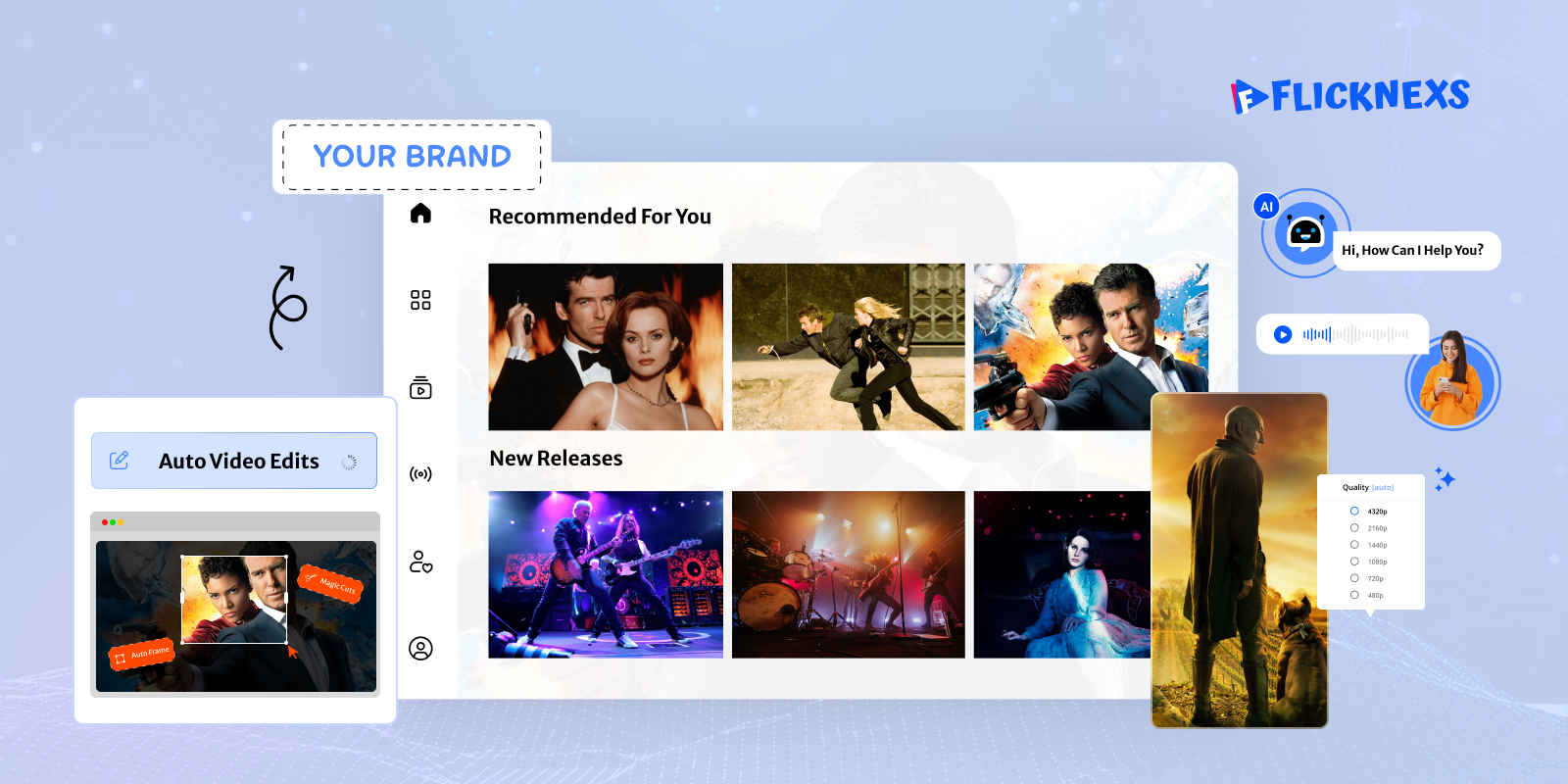OTT streaming has become the backbone of modern entertainment, with over 1.5 billion subscribers worldwide and global revenue projected to reach $210 billion by 2025 (Statista). Platforms like Netflix, Disney+, Hulu, and Amazon Prime Video have transformed viewing habits, offering on-demand content anytime, anywhere.
However, this growth comes with challenges. Low engagement, high churn, and content saturation make it harder for platforms to retain viewers and monetize effectively. Users often feel overwhelmed by the options, and generic content fails to keep them engaged.
This is where AI in OTT streaming platforms plays a crucial role. Leveraging machine learning, predictive analytics, natural language processing, and computer vision, AI provides personalized recommendations, smarter content discovery, dynamic ads, and optimized monetization. By integrating AI, platforms can deliver highly engaging, seamless, and personalized experiences, resulting in increased revenue.
In this blog, we’ll explore 10 ways AI is boosting engagement and revenue for OTT platforms, complete with stats, real-world examples, and actionable insights.
1. Personalized Content Recommendations
AI allows platforms to deliver content tailored to each viewer’s preferences by analyzing viewing patterns, search behavior, and interactions. This ensures that users consistently encounter shows and movies that match their interests.
Personalized recommendations increase engagement and encourage longer viewing sessions. By presenting content that aligns with individual preferences, platforms can enhance user satisfaction and strengthen loyalty over time.
Impact & Stats:
- Netflix reports that 80% of the content watched comes from AI-based recommendations.
- Platforms implementing AI recommendations see a 20–30% increase in watch time (McKinsey).
- Personalized feeds can boost retention by up to 75%.
Example: Netflix uses collaborative filtering, deep learning, and reinforcement learning to continuously refine its recommendations. Disney+ uses AI to recommend content based on viewing habits, time of day, and trending content in a user’s region.
Benefits for OTT Platforms:
- Higher engagement and watch time
- Increased subscriptions due to better user satisfaction
- Reduced churn as viewers stay for content they love
Challenges & Considerations:
- Requires large-scale data infrastructure
- Privacy compliance must be ensured when collecting user data
2. Smarter Content Discovery
AI improves content discovery through advanced search and recommendation systems. Viewers can find niche or hidden content more easily, reducing the frustration of endless scrolling and improving overall user experience.
Smarter content discovery keeps audiences engaged and ensures that all content, not just popular titles, reaches the right viewers. This helps maintain a dynamic and engaging platform that meets diverse viewer needs.
Stats:
- Adobe reports a 20–30% increase in content engagement on platforms with AI-driven search.
- User satisfaction increases by 15–25% when search results are accurate and personalized.
Example: Amazon Prime Video suggests content based on viewing habits, trending topics, and regional preferences. Spotify (music OTT) uses AI to recommend songs and podcasts, uncovering hidden gems users might never find manually.
Benefits:
- Keeps users engaged by helping them explore new content
- Reduces decision fatigue from overwhelming libraries
- Promotes long-tail content, increasing overall platform value
Trends: AI is now integrating voice search and multilingual search, allowing global audiences to discover content in their preferred language.
Challenges:
- NLP models may struggle with slang, regional language, or new content descriptors
- Continuous retraining required to handle evolving content trends
3. Dynamic Ad Insertion & Targeting
AI enables personalized and context-aware advertising, replacing generic ads with ones tailored to individual viewer behavior and preferences. This approach enhances ad relevance while maintaining a smooth viewing experience.
Dynamic ad insertion improves engagement with ads and increases revenue potential. By delivering advertising that aligns with viewer interests, platforms can balance monetization with user satisfaction.
Stats:
- AI-driven ad targeting increases click-through rates by up to 30% (eMarketer).
- Platforms using AI-powered AVOD models can boost revenue per user by 20–25%.
Example: Hulu uses AI to analyze viewing patterns and dynamically insert ads based on demographics, interests, and engagement history. YouTube uses Google AI to select ads most relevant to viewers, maximizing revenue while minimizing viewer irritation.
Benefits:
- Higher ad engagement and revenue
- Improved user experience by reducing irrelevant ads
- Better ROI for advertisers
Challenges:
- Balancing ad frequency and user experience
- Ensuring compliance with privacy regulations
4. Predictive Analytics for User Retention
AI can anticipate which users may disengage or cancel subscriptions based on viewing patterns and behavior. Platforms can then send targeted notifications, offers, or content suggestions to retain these users.
Predictive analytics supports proactive retention strategies, helping platforms maintain loyal audiences. By addressing potential churn before it happens, platforms strengthen long-term user relationships and engagement.
Stats:
- Predictive analytics can reduce churn by up to 25% in OTT platforms (Deloitte).
- Personalized retention strategies can increase average revenue per user by 15–20%.
Example: Disney+ uses predictive analytics to send personalized content notifications, promotional offers, and reminders to keep at-risk users engaged. Netflix monitors inactivity patterns and suggests fresh content before users leave.
Benefits:
- Retains high-value users
- Improves lifetime value (LTV)
- Increases subscription renewals
Challenges:
- Requires accurate data collection and analysis
- Must avoid over-communication, which can annoy users
5. Automated Video Editing & Content Creation
AI can automate video editing, highlight generation, and even content production, reducing manual workload and operational costs. This ensures a faster content delivery process while maintaining quality.
Automation allows platforms to scale content efficiently and consistently. By streamlining production workflows, AI frees up resources for creative development and enhances overall content output.
Stats:
- AI-driven automation can reduce production time by 50–70% (PwC).
- Platforms can increase output by 2–3x without additional resources.
Example: ESPN uses AI to generate auto-highlights from live sports events. Netflix is experimenting with AI tools that suggest cuts, scene sequences, and trailers automatically.
Benefits:
- Faster content delivery
- Reduced production costs
- Consistent quality across multiple content pieces
Trends: AI is increasingly used for deepfake trailers and synthetic content for marketing campaigns.
Challenges:
- May compromise creativity if over-relied upon
- AI-generated content may not always meet brand quality standards
- Technical expertise required to maintain tools
6. Enhanced Streaming Quality with AI
AI optimizes streaming quality by adjusting video delivery based on network conditions and device capabilities. This reduces buffering and ensures a smooth, uninterrupted viewing experience.
Enhanced streaming quality improves user satisfaction and engagement. Viewers are more likely to stay on the platform when playback is seamless and reliable, creating a better overall experience.
Stats:
- Platforms implementing adaptive AI streaming see 30% fewer buffering complaints (Akamai).
- Average watch time increases by 15–20% due to seamless viewing.
Example: YouTube’s AI-driven adaptive streaming adjusts video resolution based on network conditions. Netflix uses dynamic encoding powered by AI to reduce buffering during peak hours.
Benefits:
- Improved user experience
- Higher engagement and watch time
- Reduced churn due to technical issues
Challenges:
- High computational cost for real-time optimization
- Complex implementation across devices
- May require continuous monitoring for peak hours
7. AI-driven Content Moderation
AI can automatically detect and filter inappropriate, offensive, or pirated content. This ensures that the platform remains compliant and safe for all viewers.
Content moderation protects the platform’s reputation and builds trust with audiences. By maintaining a secure and compliant content library, AI supports a positive user environment.
Stats:
- Automated moderation reduces manual review workloads by up to 60% (Microsoft AI Report).
- Detection accuracy improves over time with machine learning, reaching over 95% accuracy in some platforms.
Example: TikTok’s AI scans uploaded videos for copyright violations, explicit content, or hate speech before publishing.
Benefits:
- Ensures compliance with regional laws
- Protects users from harmful content
- Reduces operational costs for moderation
Challenges:
- False positives/negatives can block legitimate content or miss violations
- Needs continuous training for new types of content
- Language and context can be tricky to moderate
8. Voice & Chatbot Assistants for OTT Platforms
AI-powered voice assistants and chatbots simplify navigation, content search, and troubleshooting for viewers. Users can find content or resolve issues more quickly and conveniently.
These assistants enhance accessibility and improve user experience. By reducing friction in content discovery and support, AI contributes to higher engagement and satisfaction.
Stats:
- Platforms using AI assistants see 25–40% improvement in user support efficiency (Gartner).
- 60% of users prefer voice commands for searching content (Voicebot.ai).
Example: Netflix integrates Alexa and Google Assistant for voice-based playback and search. Disney+ allows voice-based content browsing through smart TVs and mobile apps.
Benefits:
- Enhances accessibility for differently-abled users
- Speeds up content discovery
- Reduces support ticket load
Challenges:
- Misinterpretation of voice commands or queries
- Integration complexity with multiple devices
- May not fully replace human support for complex issues
9. Smarter Revenue Models with AI Insights
AI analyzes user behavior to recommend optimal monetization strategies, whether subscription-based, ad-supported, or transactional. Platforms can align pricing and content offerings with audience preferences.
Intelligent revenue optimization helps platforms maximize income while maintaining user satisfaction. By using data-driven insights, platforms can make informed decisions that enhance profitability and engagement.
Stats:
- AI-driven revenue optimization can increase platform income by 15–20% (McKinsey).
- Platforms see better engagement and retention when the right monetization model is applied.
Example: Hulu offers hybrid plans where AI determines whether a user benefits more from ad-supported or premium subscription based on viewing behavior and demographics.
Benefits:
- Maximizes revenue without compromising user experience
- Helps identify underperforming revenue streams
- Supports data-driven decision-making
Challenges:
- AI models may misinterpret user behavior, leading to wrong pricing or offers
- Dependence on historical data may not capture new trends
- Requires frequent model updates for accuracy
10. Future of AI in OTT – Next-Level Immersion
AI is driving the future of OTT through immersive experiences using VR, AR, and hyper-personalization. Platforms can adjust visuals, audio, and content dynamically based on viewer preferences, creating highly engaging experiences.
This next-level immersion allows viewers to interact with content in ways previously not possible, enhancing engagement and satisfaction. As AI continues to evolve, OTT platforms leveraging immersive technologies will set new standards for digital entertainment.
Stats:
- The immersive media market is projected to reach $215 billion by 2030 (Grand View Research).
- Early adopters of AI + VR in OTT see higher engagement rates, sometimes up to 40% more than traditional streaming.
Example: Imagine a VR concert where AI adjusts camera angles, audio levels, and visual effects based on your preferences, creating a fully personalized immersive experience.
Benefits:
- Highly engaging, interactive content
- Differentiates platforms in a crowded market
- Creates opportunities for premium pricing
Challenges:
- High development costs for VR/AR experiences
- User adoption may be slow initially
- Hardware limitations for viewers (VR headsets, AR devices)
Conclusion
AI is transforming OTT streaming platforms by addressing challenges like low engagement, content overload, churn, and revenue optimization. From personalized recommendations to predictive analytics, dynamic ads, automated editing, and immersive experiences, AI empowers platforms to retain viewers, increase watch time, and maximize revenue.



Leave a Reply